The wiki is lacking in content. You can help by creating a new article. See the to do list for more ways you can help.
New user registration has been restored. Thank you for your patience.
Welcome Indie Wiki Jammers! Check out here for info on the jam
Final Fantasy
| Final Fantasy | |
|---|---|
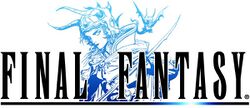 Logo used since the PSP release | |
|
ファイナルファンタジー | |
| Developer(s): | |
| Publisher(s): |
Square |
| Platform(s): |
Nintendo Entertainment System, MSX2, WonderSwan Color, PlayStation, Mobile phone, Virtual Console (Wii, Wii U, 3DS), PlayStation Portable, iOS, Android, Windows Phone, 3DS, NES Classic Edition |
| Release date: |
Famicom/NES: |
| Genre: |
Role-playing game |
| Modes: |
Single player |
| Ratings: |
CERO: A |
| On partnered websites | |
| Switcher.gg: | Find Final Fantasy friends online |
| This article is about the first Final Fantasy game. For information on the series itself, see Final Fantasy (series). For the music piece that plays in most games of the series, see Final Fantasy (song). |
Final Fantasy, sometimes known as Final Fantasy I, is the first installment of the Final Fantasy franchise and its main series. The game was developed and published by Square. It was originally released in Japan for the Famicom in 1987 and for the Nintendo Entertainment System in North America in 1990.
Final Fantasy has been re-released on numerous consoles, namely MSX2, WonderSwan Color, PlayStation, Game Boy Advance, PlayStation Portable, iOS, Android, and Nintendo 3DS. There are a few compilations in which Final Fantasy is packaged with its follow-up, Final Fantasy II, including Final Fantasy I∙II (Famicom), Final Fantasy Origins (PlayStation) and Final Fantasy I & II: Dawn of Souls (Game Boy Advance). The Final Fantasy Origins version also received a standalone release in Japan. The original Famicom/NES version of Final Fantasy has been released on Nintendo's Virtual Console for the Wii, Nintendo 3DS, and Wii U.
In 2004, Final Fantasy was released on two series of Japanese cell phones. In February, it was released for the NTT DoCoMo 900i series. In August, it was released for the CDMA 1X WIN W21x series.
In 2021, the Final Fantasy Pixel Remaster version of Final Fantasy was released alongside the Pixel Remaster versions of Final Fantasy II and Final Fantasy III.
Story[edit]
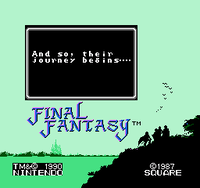
Four hundred years prior to game's events, the Lufenian race used the power of wind to craft a giant space station called the Flying Fortress and airships. They watched their country decline as the Wind Crystal went dark. Two hundred years later, violent storms sunk a massive shrine that served as the center of an ocean-based civilization, and the Water Crystal went dark. The Earth Crystal and the Fire Crystal followed, plaguing the earth with raging wildfires and devastating the agricultural town of Melmond as its plains and vegetation decayed. Some time later, a sage called Lukahn tells of a prophecy that four Light Warriors will save the world in a time of darkness.
The game begins with the appearance of the four youthful Warriors of Light, who each carry one of the darkened Crystals. They arrive at the kingdom of Cornelia, whose princess, named Princess Sarah, was kidnapped by an evil knight named Garland. The Warriors of Light confront Garland at the Chaos Shrine, defeat him, and return Sarah to Cornelia. Out of gratefulness, the King of Cornelia orders the construction of the drawbridge, allowing the Warriors of Light to access reach the second town, Pravoka.
At Pravoka, the Warriors of Light liberate the town from Bikke and his pirates and obtain their ship to use on the overworld. The ship does not allow the Warriors of Light to travel outside of the Aldi Sea. Meanwhile, the Warriors of Light learn of a dark wizard named Astos, has been causing trouble at nearby locations. The third town, Elfheim, is located to the south of Aldi Sea. There, the Warriors of Light discover that the prince was cast into a cursed sleep by Astos. He also stole Matoya's Crystal Eye. To the west of Elfheim is the Western Keep, whose king tells the Warriors of Light that Astos stole his crown and hid it in the Marsh Cave, though when the Warriors of Light retrieve his crown, the king reveals himself to be Astos. The heroes defeat Astos and continue with their journey. When the Warriors of Light retrieve Matoya's Crystal Eye, she gives them the Jolt Tonic to awaken the Elf Prince. By doing so, the Elf Prince rewards them with the Mystic Key. With the Mystic Key, the Warriors of Light return to Castle Cornelia and unlock a specific room with the Nitro Powder. At Mount Duergar, the dwarves use the Nitro Powder use to destroy a small isthmus, allowing the Warriors of Light to access more of the overworld.
After visiting Melmond, the Warriors of Light go into the Cavern of Earth, defeat the Vampire, and retrieve the Star Ruby, which allows them to access the Sage's Cave. In the Sage's Cave, a sage named Sadda gives the Earth Rod to the Warriors of Light. With the Earth Rod, the heroes access the bottommost floor of the Cavern of Earth, where the Earth Fiend Lich is fought. After the warriors defeat Lich, the Earth Crystal is restored.
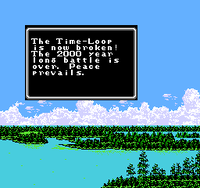
In the fifth town, Crescent Lake, the Warriors of Light find the Twelve Sages, who provide a canoe to them if they have defeated Lich. With the canoe, the Warriors of Light enter Mount Gulg and defeat Marilith, allowing the Fire Crystal to be restored. Later, the Warriors of Light visit the Cavern of Ice and obtain the Levistone. The heroes take the Levistone to Ryukahn Desert and acquire a buried airship. With the airship, the Warriors of Light go to the Cardian Islands and meet Bahamut. If the Warriors of Light have obtained the Rat's Tail from the Citadel of Trials, Bahamut upgrades each warrior's class.
When the Warriors of Light have obtained Oxyale (allowing them to breathe underwater) from Gaia, they visit Onrac and travel underwater to the Sunken Shrine. At the end of the Sunken Shrine, the Warriors of Light defeat the Water Fiend, Kraken, causing the Water Crystal to be restored and the mermaids to be freed.
After leaving Onrac, the Warriors of Light return to Melmond and take the Rosetta Stone to a linguist named Dr. Unne, who teaches the Lufenians' language to the Warriors of Light. After learning the language, the Warriors of Light visit the last town, Lufenia, where the Lufenians help the Warriors of Light reach the Flying Fortress. At the end of the Flying Fortress, the Warriors of Light encounter the Wind Fiend and last fiend overall, Tiamat. They manage to defeat Tiamat and restore the Wind Crystal.
When all four crystals are restored, an unknown character in the Chaos Shrine tries to absorb the crystals' energy into a portal that goes 2,000 years into the past. The Warriors of Light enter the portal and discover the Four Fiends, which were created by Chaos (revealed to be Garland) back then to access the future and create a time loop allowing him to live forever.
The Warriors of Light defeat Chaos, which ends the paradox, and they return to the present. With the time loop broken, peace returns to the world. The Warriors of Light and the people are unaware of the events that occurred, although order has been restored and the darkness has been vanquished.
Gameplay[edit]
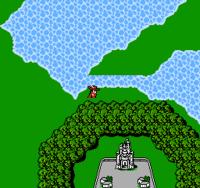
When starting the game, the player must choose from six classes to add to their party, the Warriors of Light. Each class has their own attributes and abilities. Three classes are physically oriented, and the other three are mages, who are oriented in magic. The player can only choose four members, so the game strategy changes accordingly depending on which characters the player chose. Like several role-playing games of its time, Final Fantasy's player characters are passive participants in the story, with their names and abilities relevant only during battle. In the original Nintendo Entertainment System version, the player can only input up to four letters for each character's name.
A character's most basic attribute is its level, which is numbered between 1-50 (or up to 99 in remakes). Each character's level is determined by how much experience they have, and characters become stronger as they level up. Each character has a different number for their attributes, such as maximum HP, which represents their remaining health. When a character reaches zero HP, they die. Other attributes, such as Attack and Defense, show how experienced the character is in those aspects. In one part of the game, if the warriors complete a quest for Bahamut, he upgrades each of them to a stronger class.
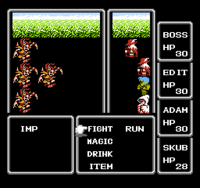
The Warriors of Light can travel to the various locations from the overworld. While traveling, the Warriors of Light encounter monsters that they must fight in a turn-based battle. At the start of each turn, the player must select an action for each character, with the options including a direct attack, casting spells, using magical items, or fleeing. Once the player has selected an action for each warrior, they and the enemies begin to fight. Participants move one at a time in a randomly determined order. In the original NES version, if a character had chosen to attack an enemy who had been defeated earlier in the round, they do not attack another enemy, rendering their turn ineffective. This was fixed in remakes. The battle ends when either side flees or is defeated. If the Warriors of Light win a battle, they earn experience points, which strengthen the characters, and gil, which is the game's currency.
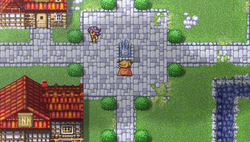
In towns, the Warriors of Light can shop for items, weapons, and magic spells. There is an inn where they can sleep overnight to fully restore their HP and MP. There are also non-playable characters that they can talk to, several of whom provide them with information or hints on progressing through the adventure.
At shops, the Warriors of Light can buy items to help themselves recover while they are traveling. They can carry up to 99 of each item at a time. There are common items, such Potions, which restore HP to a character, and Antidotes, which cure a character with the poison ailment. Some items are obtained in chests in certain areas. There are unique and essential items known as key items, which have a direct role during a certain part of the adventure. The Warriors of Light can use Sleeping Bags, Tents, or Cottages on the overworld to restore their HP. Using a Cottage also restores their HP.
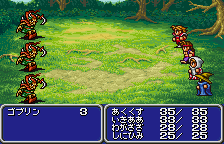
There are six types of weapons: Swords, Daggers, Axes, Hammers, Staffs, and Nunchaku. A character can be equipped with four weapons, although they can only use one at a time. The type of a weapon mainly determines its associated graphics and the characters who can use it. Each weapon has three statistics: damage, chance to hit bonus, and critical hit chance. Some weapons are more effective against monsters, based on their type or vulnerability to certain elements. In the original NES version, a programming bug prevents the properties and the critical hit chance from being used.
Aside from weapons, there are four types of defense armor: Armor (which includes Cuirasses, Robes, and Bracelets), Helmets, Gauntlets, and Shields. Like weapons, a character can be equipped with up to four pieces of armor, but only one of each type. Each armor has two statistics: a damage absorption bonus and an evade penalty. Certain armor also protects the wearer from certain types of magic.
The mages and their respective upgraded wizard classes can use magic, which is separated into White Magic and Black Magic, which are respectively focused on defense and offense. Spells are classified by a level between one and eight, with the higher level spells being more powerful than lower level spells. The mages (or wizards) may learn up to three spells of each level by purchasing them at the respective Black Magic and White Magic Shops, each having spells of a certain level for sale. Black Mages can only learn Black Magic, White Mages can only learn White Magic, and the Red Mage can learn a mix of both. More than three spells are usually sold at Magic Shops, so the player must be strategic of which spells they choose for their character. In the original NES version, a mage or wizard cannot forget any spells they have learned. This was changed in the remakes.
In the original NES version, rather than using Magic Points (MP), mages and wizards were granted "charges" for each level of spells, similar to the spell-casting system of Dungeons & Dragons. Certain level spells can be cast as many times as the user had charges. Characters at higher levels have more charges.
Characters[edit]
- Main article: List of characters in Final Fantasy
Playable characters[edit]
There are six playable characters, each of a different class, who are collectively known as the Warriors of Light. At the start of the game, the player can only select four warriors for the duration of the game, and they can name each of them. Like computer role-playing games of the era, the player characters, in this case the Warriors of Light, are passive participants in the story, and therefore the player's choice of character type affects only the warriors' abilities in battle.
Each warrior's stats are determined by eight categories: Hit Points (HP), Agility (Agi), Vitality (Vit), Magic Defence (M. Def), Strength (Str), Intelligence (Int, Hit Percentage (Hit%), and Luck.
| Sprite (NES) | Name | HP | Strength | Agility | Intelligence | Vitality | Luck | Description |
|---|---|---|---|---|---|---|---|---|
| Black Mage | 25 | 1 | 10 | 20 | 1 | 20 | This character can cast offensive spells. Its upgraded class is Black Wizard. | |
| Monk | 33 | 5 | 5 | 5 | 20 | 10 | This character is skilled at fighting armorless and without a weapon. Its upgraded class is Master. | |
| Red Mage | 30 | 5 | 5 | 15 | 10 | 20 | Of the three mages, the Red Mage is the strongest at physical attacks. It can use a mixture of White and Black Magic. Its upgraded class is Red Wizard. | |
| Thief | 30 | 5 | 10 | 5 | 5 | 15 | A fast and agile character who can be upgraded into Ninja, who can use low-level Black Magic spells. | |
| White Mage | 28 | 5 | 5 | 15 | 10 | 20 | This character can cast defensive and curative spells. Its upgraded class is White Wizard. | |
| Warrior | 35 | 20 | 5 | 1 | 10 | 5 | This character uses heavy weapons and armor, and can be upgraded into a Knight, who can also use low-level White Magic spells. |
Enemies[edit]
- Main article: Final Fantasy bestiary
In later releases, starting with Final Fantasy Origins, there is a Bestiary from the main menu, and it lists each enemy and their stats.
Bosses[edit]
- Garland
- Astos (Dark Elf)
- Piscodemon
- Vampire
- Death Eye
- Blue Dragon
- Lich, fiend of earth
- Marilith, fiend of fire
- Kraken, fiend of water
- Tiamat, fiend of wind
- Chaos
Release history[edit]
| This section uses content from Wikipedia (view authors), and falls under the compatible Creative Commons license. |
North American localization[edit]
The 1990 North American localization of Final Fantasy by Nintendo of America was essentially identical to the original Japanese game, although most names were changed for various reasons. Gameplay remained essentially the same, with changes limited to a few battle formations and removal of all random encounters from the final floor of the final dungeon.
The majority of name changes resulted from technical limitations on name length, for example the spell "Thunder" being reduced to "LIT". Nintendo of America's censorship policies resulted in removal of religious references, such as the spell "Holy" being renamed to "FADE" and the Church being changed to Clinic, and the elimination of nudity from certain monster images. Some changes, such as "Beholder" to "EYE" with a vastly different image, were presumably made for copyright reasons. Most Light Warrior battle graphics were slightly altered, along with the graphical changes to remove religious imagery.
Square Enix released the original NES version on the Wii's Virtual Console in Japan and North America in 2009 and in PAL territories in 2010. This version would later be released again for the Wii U's Virtual Console in 2013.
On November 11, 2016, Final Fantasy was included as one of the 30 games on the NES Classic Edition.
MSX2[edit]
The MSX2 computer standard was roughly analogous, in terms of technical capabilities, to the NES, and as a result, the MSX2 version of Final Fantasy is probably the closest to the original Famicom version. However, while the Famicom was designed to operate exclusively as a gaming console, the MSX2 was intended to be used more generally as a personal computer. In practice, this meant that the game was subtly altered to take advantage of certain features offered by the MSX2 and not by the Famicom, and vice versa.
Due to its release on floppy diskette, the MSX2 version of the game had access to almost three times as much storage space as the Famicom version (720 KB vs. 256 KB), but suffered from a variety of problems not present in Nintendo's cartridge media, including noticeable loading times. There were also relatively minor graphical upgrades. In general, the MSX2 version sports an ostensibly improved color palette which adds a degree of vibrancy to character and background graphics. In addition, the world map seems to have been moved slightly, meaning that the placement of monster "areas" on the world map is slightly different, and that monsters appear in different places than in the Famicom version.
Compilations[edit]
Released both individually (in Japan only) and alongside its follow-up, Final Fantasy II in a collection entitled Final Fantasy Origins (or Final Fantasy I+II Premium Collection in Japan), the PlayStation port of Final Fantasy by TOSE was based on WonderSwan Color version. Most of the changes instituted in that version of the game remain in this version. However, there are a few differences. Although the graphics are basically the same as in the WonderSwan Color version, the higher screen resolution of the PlayStation means that most have been improved to some degree, with more detail. Tsuyoshi Sekito also remixed the soundtrack to Final Fantasy IX quality to utilize the audio capabilities of the Sony PlayStation and also composed a few new tracks like the ones used in the opening movies.
In 2004, both Final Fantasy and Final Fantasy II were released for the Game Boy Advance, both on the Final Fantasy I & II: Dawn of Souls compilation. The difficulty level of the Game Boy Advance version most closely resembles the "easy mode" of the Final Fantasy Origins. Unlike that version, however, there is no option to switch back to the original difficulty level. Similarly, the redirection of "ineffective" hits, which had been optional since it was introduced in the WSC version, is now mandatory.
Mobile phones[edit]
In 2004, Square Enix released a version of Final Fantasy for two Japanese mobile phone networks. A version for NTT DoCoMo FOMA 900i series phones was launched on March 1, 2004 under the title Final Fantasy i. A subsequent version for the CDMA 1X WIN-compatible W21x series was released on August 19, 2004 as Final Fantasy EZ. Another version, simply titled Final Fantasy, was also released for SoftBank Yahoo! Keitai phones on July 3, 2006. Graphically, the games are superior to the original 8-bit game, but not as advanced as many of the more recent console and handheld ports.
Square Enix planned to release this version for North American mobile phones in 2006, but it was delayed to 2010 and released in collaboration with Namco. It retains the game difficulty and "spell level"-based magic system from the original Famicom version. Other elements such as updated graphics, spell names, and monster names are borrowed from the Game Boy Advance / WonderSwan Color versions, not including the additional dungeons, monsters and items present in the GBA version. Game data is saved as in the original Famicom version (by using Tent, Sleeping Bag, and Cottage or by going into an inn). However, there are now three save game slots and a "Temporary Save" option available in the game.
PlayStation Portable[edit]
For the Final Fantasy 20th Anniversary, Square Enix remade both Final Fantasy and Final Fantasy II for the PlayStation Portable, each having a separate release. The games were released in Japan and North America in 2007, and in European territories in 2008. The PSP version features higher-resolution 2D graphics, full motion video sequences, a remixed soundtrack, and a new dungeon as well as the bonus dungeons from Dawn of Souls. The script is the same as in the Final Fantasy I & II: Dawn of Souls version, aside from the new dungeon.
iOS and Android[edit]
On February 25, 2010, Square Enix released the iOS version of Final Fantasy, based on the PSP port with touch controls, worldwide. On June 13, 2012, Square Enix released the Windows Phone version, which itself is based on the iOS version. On July 27, 2012, Square Enix released an Android port, largely based on the iOS version though lacking the new dungeons of the 20th Anniversary Edition.
Pixel Remaster[edit]
On July 28, 2021, the first three Final Fantasy Pixel Remaster games were released, including Final Fantasy. These games, initially released for PC and mobile, were designed to be modern re-renditions of the original releases, without most of the optional content added in newer versions of the games - in particular, the new equipment and dungeons from the Dawn of Souls and 20th Anniversary releases. The Pixel Remaster of Final Fantasy was later released on the Playstation 4 and the Nintendo Switch on April 19, 2023 with a host of additional quality of life features, as part of the Final Fantasy I-VI Pixel Remaster Collection.
Versions and re-releases[edit]
| No. | Released | Platform(s) |
|---|---|---|
| 1 | Nintendo Entertainment System | |
| 2 | MSX2 | |
| 3 | WonderSwan Color | |
| 4 | PlayStation | |
| 5 | NTT DoCoMo FOMA 900i | |
| 6 | i-mode | |
| 7 | Game Boy Advance | |
| 8 | CDMA 1X WIN W21x series | |
| 9 | EZweb | |
| 10 | Softbank 3G (Yahoo!) | |
| 11 | PlayStation Portable | |
| 12 | Virtual Console (Wii) | |
| 13 | PlayStation Network | |
| 14 | iOS | February 25, 2010 (worldwide) |
| 15 | Android | December 1, 2011 (worldwide) |
| 16 | Windows Phone | June 13, 2012 (worldwide) |
| 17 | Virtual Console (Wii U) | |
| 18 | Virtual Console (3DS) | |
| 19 | Nintendo 3DS (eShop) | |
| 20 | NES Classic Edition | November 11, 2016 (worldwide) |
| 21 | Final Fantasy Pixel Remaster | July 28, 2021 (worldwide) |
References to and from other media[edit]
- References in Final Fantasy to other media
- This game draws a inspiration from Dungeons and Dragons, first Edition.
- References to Final Fantasy from other media
- This game serves as the basis for 8-Bit Theater. The comic follows the basic plot, albeit with artistic license and creative liberties given to help flesh out the minor details. It ran for 1224 issues and an epilogue.
See also[edit]
- Comparison of Final Fantasy names between versions - A comparison of names used between different versions of the game.
- Final Fantasy version differences - Differences between the several versions of the game.
- Final Fantasy regional differences - Regional differences for every version of the game.
- List of glitches in Final Fantasy - A list of glitches found in the game.
- List of Final Fantasy staff - The people who developed the game.
External links[edit]
- NES version on Final Fantasy Kingdom
- Final Fantasy on TV Tropes Wiki